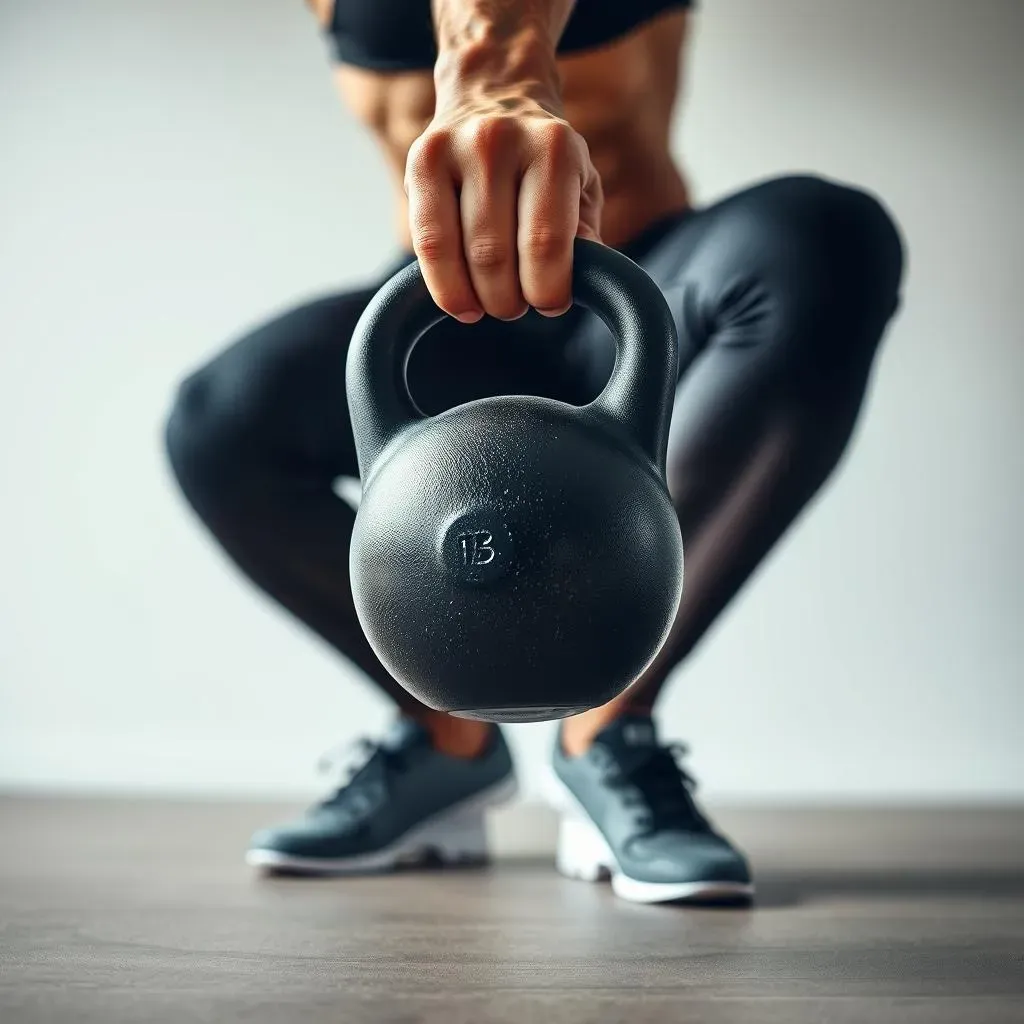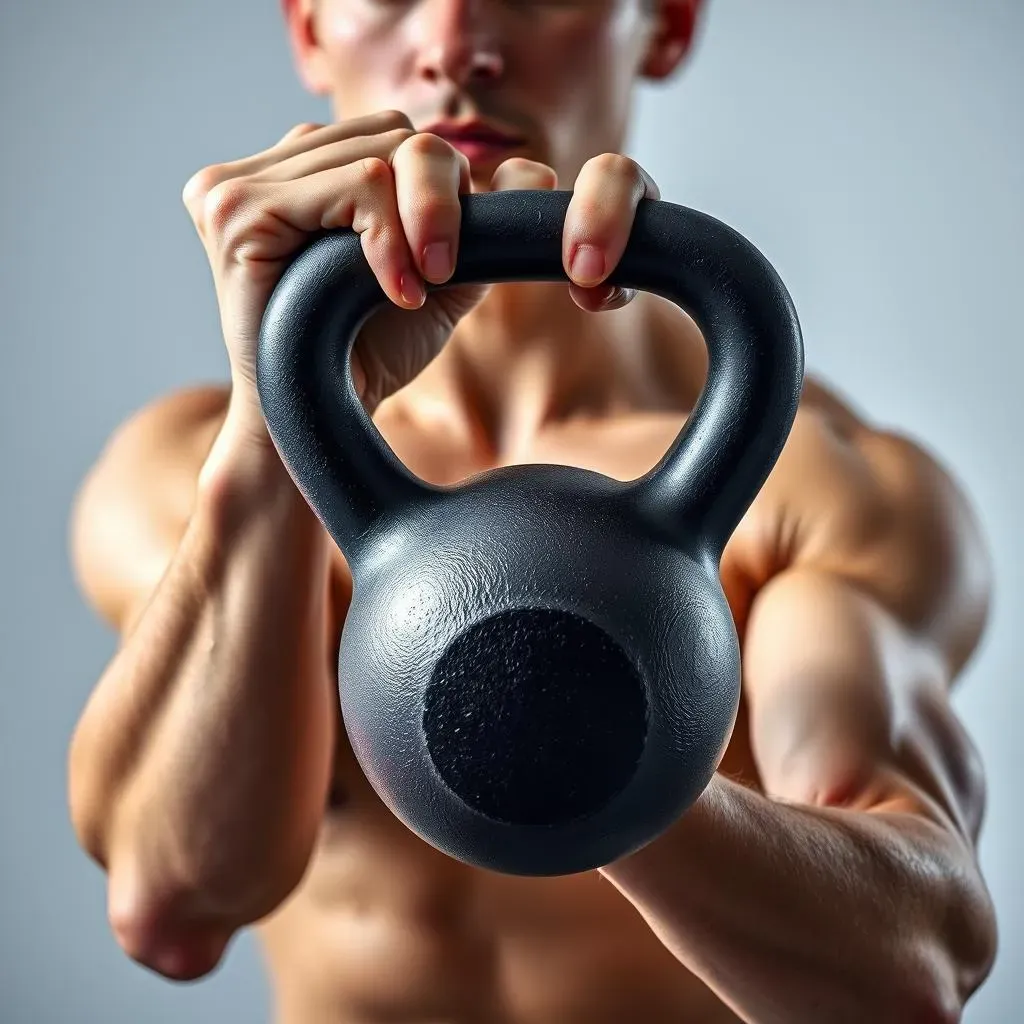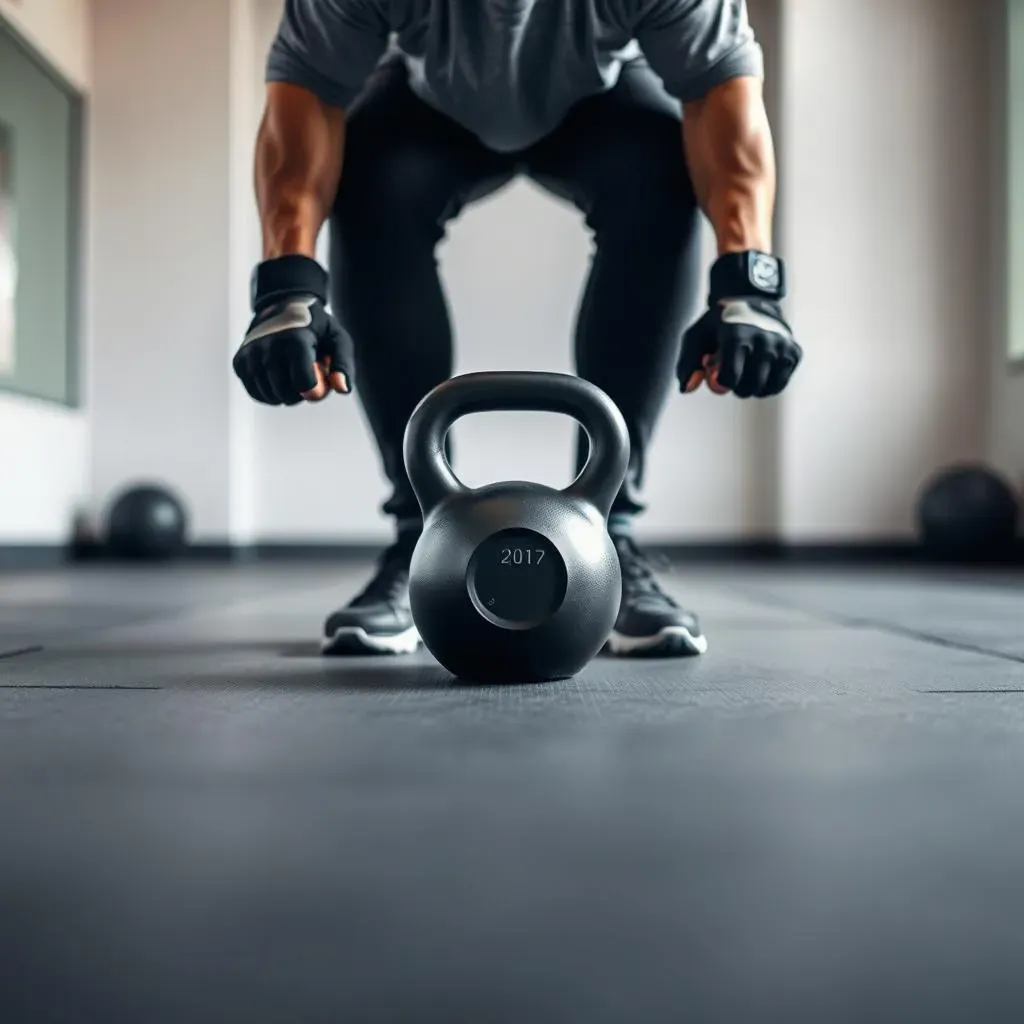Table of Contents
Ready to transform your back and shoulders? Forget those boring, predictable routines! We're diving into the world of bottoms-up kettlebell training, a method that'll not only sculpt your muscles but also crank up your stability like never before. This isn't about just lifting weights; it's about mastering control and balance, which translates to real-world strength. In this article, we’ll explore 13 killer exercises that will challenge you in ways you never thought possible. We’ll start with a proper warm-up, move into the core workout, and then focus on safety to make sure you’re getting the most out of your "kettlebell workout for back and shoulders" without any risk. Think of this as your guide to unlocking a stronger, more resilient you. Get ready to feel the burn, improve your posture, and have some fun along the way. Let’s get started!
Kettlebell WarmUp: Preparing Your Body for Action

Kettlebell WarmUp: Preparing Your Body for Action
Alright, before you even think about swinging a kettlebell, let's get your body ready. A proper warm-up isn't just some formality; it's your secret weapon against injury and for maximizing your workout. Think of your muscles like a car engine on a cold morning; you wouldn't just slam the pedal to the metal, would you? We need to get things moving, blood flowing, and those joints nice and loose. We're not talking about a marathon session here, just a few minutes of focused activity to prime your body for what's coming. So, let's ditch the static stretches for now, and instead, focus on dynamic movements that mimic the exercises we'll be doing.
We'll start with some arm circles, shoulder rotations, and leg swings. These aren't just random movements; they're designed to target the specific muscles you'll be using. Think about it, we're about to work those shoulders and back, so we need to give them some attention beforehand. A few light cardio exercises like jumping jacks or high knees can also help to raise your heart rate and get your blood flowing. The goal here is to get you feeling warm and ready, not exhausted. Don't rush, listen to your body, and if something feels uncomfortable, ease up. This warm-up is your personal preparation, tailored to what you need, and not a competition to see who can go the fastest. Let's get moving!
Warm-up Exercise | Reps/Duration | Focus |
|---|---|---|
Arm Circles | 10 forward, 10 backward | Shoulder mobility |
Shoulder Rotations | 10 each direction | Joint flexibility |
Leg Swings | 10 each leg | Hip and leg activation |
Jumping Jacks | 30 seconds | Cardio and body activation |
High Knees | 30 seconds | Cardio and leg activation |
The Ultimate Kettlebell Workout for Back and Shoulders

The Ultimate Kettlebell Workout for Back and Shoulders
Bottoms-Up Basics
so you've warmed up, and now you're itching to get into it. Let's talk about the star of our show: the bottoms-up kettlebell technique. This isn't your everyday kettlebell workout. Holding the kettlebell with the round part facing up might seem a little weird at first, but trust me, it's a game-changer. This position instantly makes the exercises more challenging, forcing your stabilizer muscles to work overtime. It’s like trying to balance a tray of drinks – you need to be extra careful and engage your core to avoid spills. The same goes for your body when using this technique. We are not just building strength; we are building control and stability.
The focus here is on slow, controlled movements. Forget about swinging the weight around like a wild thing. We're aiming for precision and engagement. When you're doing a press or a row with the kettlebell upside down, every muscle in your arm, shoulder, and back has to work together to keep it steady. It's a full-body workout disguised as an arm exercise. This is why a "kettlebell workout for back and shoulders" using the bottoms-up method is so effective. This technique not only builds strength but also enhances your balance and coordination. Think of it as a way to make your body smarter, not just stronger.
13 Exercises to Transform Your Upper Body
Now, let's get to the juicy part: the 13 exercises that'll whip your back and shoulders into shape. We're not going to just list them and leave you hanging; I'll give you a quick rundown of each one. Remember, form is king, so start with lighter weights until you're comfortable with the movement. We've got everything from presses and rows to squats and carries, all designed to work your muscles in different ways. It's not just about pushing and pulling; it's about understanding how your body moves and using the kettlebell to enhance that movement. Each exercise is a new opportunity to challenge yourself and push your limits.
We will start with the basics like the single-arm press, where you’ll feel the burn in your shoulder and core. Then, we'll move to rows, which are fantastic for your back and biceps. After that, we’ll incorporate some squats with a bottoms-up hold to really engage your legs and core. And don't even get me started on the carries; they are brutal, but they are a great way to build full-body strength. Remember, it's not about powering through as many reps as possible, but about doing each rep with purpose and control. This isn't a race; it's a journey to building a stronger, more resilient body.
Exercise | Reps (per side) | Sets | Focus |
|---|---|---|---|
Bottoms-Up Single-Arm Kettlebell Shoulder Press | 8-10 | 3 | Shoulder strength, stability |
Bottoms-Up Kettlebell Row | 10-12 | 3 | Back and bicep strength, grip |
Bottoms-Up Kettlebell Squat | 10-12 | 3 | Legs, core, shoulder stability |
Bottoms-Up Kettlebell Carry | 30-60 seconds | 3 | Full-body strength, stability |
Bottoms-Up Kettlebell Swing to Hold | 8-10 | 3 | Full body power, core, grip |
Why This Approach Works
You might be wondering why we're going through all this trouble with the bottoms-up method. It’s not just about making things harder for the sake of it, there is a method to the madness. This approach forces your muscles to work in a more balanced way. When the weight is upside down, every little wobble becomes a challenge that your body has to overcome. This means you're not just building strength; you're also improving your proprioception, or your body's awareness of its position in space. This is super important for everyday movement and injury prevention. You'll be amazed how much more stable you feel after just a few weeks of training this way.
Plus, it's just more fun! There’s something really satisfying about mastering a challenging movement. It’s like solving a puzzle with your body. And, when you nail that perfect press with the kettlebell balanced upside down, you will feel pretty awesome. This type of training keeps your body guessing, preventing you from hitting plateaus. So, if you’re looking for an engaging and effective way to build your back and shoulders, give this a try. You may end up loving it as much as I do. It's not just about lifting weights; it's about becoming a more capable and resilient version of yourself.
Mastering Kettlebell Form: A Guide to Safe Exercises

Mastering Kettlebell Form: A Guide to Safe Exercises
The Importance of Proper Form
so you're excited about this kettlebell workout, and that's awesome. But let's pump the brakes for a sec and chat about form. I know, it might sound boring, but trust me, nailing the correct technique is not just about looking good, it's about keeping your body happy and injury-free. Think of it like building a house; you wouldn’t start with the roof, would you? You need a solid foundation, and in our case, that's proper form. When we're talking about a "kettlebell workout for back and shoulders," we're engaging some pretty complex muscle groups and joints, so we need to be extra careful. Ignoring form is like inviting a party for pain and frustration.
Poor form doesn't just make the exercises less effective, it can also lead to some pretty nasty injuries. We're talking about strains, sprains, and all sorts of other unpleasantness. It's like trying to drive a car with a flat tire; it's not going to end well. So, before you start swinging that kettlebell around like a madman, take a moment to really focus on what your body is doing. Engage your core, keep your back straight, and control the movement. It's not about lifting the heaviest weight; it's about lifting the weight correctly. Remember, we're not trying to show off, we're trying to get stronger and healthier, so let's do it right.
Key Form Pointers
Alright, let’s get down to brass tacks. We've talked about why form is important, now let's talk about how to actually achieve it. First, always engage your core. Think of it as your body's natural weight belt, protecting your spine and providing stability. Next, keep your back straight. No slouching allowed! This helps to distribute the weight evenly and avoid any unnecessary strain. And remember, control is everything. Every movement should be deliberate and focused. No jerky movements or wild swings. Imagine you're moving through thick honey; slow, deliberate, and controlled.
When it comes to the bottoms-up technique, the grip is crucial. Hold the kettlebell firmly, but not so tightly that you're tensing up your whole arm. It's a delicate balance. And finally, always listen to your body. If something feels off, stop and reassess. It's better to take a break than to push through pain. We're not trying to be superheroes here, we're trying to build a sustainable and effective workout routine. So, take your time, focus on the details, and you'll be well on your way to mastering kettlebell form.
Form Element | Description |
|---|---|
Engage Core | Tighten abdominal muscles to stabilize spine. |
Straight Back | Maintain neutral spine, avoid slouching. |
Controlled Movements | Perform exercises slowly and deliberately. |
Proper Grip | Hold kettlebell firmly but not too tightly. |
Listen to Body | Stop if you feel any pain or discomfort. |
Kettlebell Safety: Avoiding Injury During Your Workout

Kettlebell Safety: Avoiding Injury During Your Workout
Choosing the Right Weight
Alright, so you're pumped to start your kettlebell journey, and that's fantastic, but hold on a sec. Let's chat about something super crucial: picking the right weight. I know, I know, it's tempting to grab the biggest kettlebell you can find and show off your strength. But trust me, that's a one-way ticket to injury town. Think of it like trying to run before you can walk. You need to start with a weight that challenges you but doesn't compromise your form. It's not about ego; it's about building a solid foundation. Starting too heavy is like trying to build a skyscraper on a sandcastle – it's just not going to work.
So how do you know what weight is right for you? Well, if you can't complete the exercises with good form, it's too heavy. If you're struggling to control the kettlebell, it's too heavy. If you're gritting your teeth and your face is turning purple, it's definitely too heavy. Start with a weight that allows you to perform the exercises with good form. It's better to start light and progress gradually than to go too heavy and end up injured. Remember, we're in this for the long haul, so there's no need to rush. It's like learning to play an instrument; you start with the basics and gradually work your way up to the more complex pieces.
Listen to Your Body
let's talk about something that's just as important as picking the right weight: listening to your body. I know, it sounds a bit cliché, but seriously, it's crucial. Your body is like a high-performance machine; it'll let you know when something's not right. Ignoring those signals is like ignoring the check engine light in your car – it's only going to lead to bigger problems down the road. If you're feeling pain, stop. Don't try to push through it. It's not a sign of weakness; it's a sign that you're smart enough to know when to take a break.
There's a difference between the good kind of burn and the bad kind of pain. The good burn is that muscle fatigue that tells you you're working hard. The bad pain is sharp, stabbing, or persistent. If you're feeling the bad kind, stop the exercise immediately and take a break. It's better to miss a workout than to miss several weeks or months because of an injury. Think of it like a marathon runner who knows when to slow down and pace themselves. We're not in a sprint; we're in a long-term race to build a stronger, more resilient body. So be kind to yourself, listen to your body, and don't be afraid to take a break when you need it.
Symptom | Action |
|---|---|
Sharp Pain | Stop exercise immediately |
Persistent Pain | Take a break, reassess |
Muscle Fatigue | Normal, but don't push too hard |
Joint Pain | Stop exercise, check form |
Proper Environment and Gear
Last but not least, let's talk about setting yourself up for success. Your workout environment and gear play a big role in safety. First, make sure you have enough space. You don't want to be swinging a kettlebell around in a cramped room. It's like trying to dance in a phone booth – it's just not going to work. Find a space where you have plenty of room to move without bumping into anything. Next, make sure you have good footing. A non-slip surface is essential to avoid any slips or falls, it’s like wearing the right shoes for a hike, it makes all the difference.
And let's not forget about your gear. Make sure you're wearing comfortable clothing that allows you to move freely. And consider using gloves if you have sweaty hands, that can help you maintain a firm grip on the kettlebell. It's the little things that can make a big difference. Creating a safe and comfortable workout environment isn’t just about avoiding injury. It’s also about creating a space where you can focus on your workout and enjoy the process. So take some time to set things up right, and you'll be well on your way to a safe and effective "kettlebell workout for back and shoulders". It is like preparing a kitchen before you start cooking, it makes the whole process more enjoyable and less stressful.
Wrapping Up Your Kettlebell Journey
So, there you have it, a complete guide to transforming your back and shoulders with the power of bottoms-up kettlebell training. Remember, it's not about rushing through the exercises or lifting the heaviest weight you can find. It’s about control, stability, and consistent effort. Start light, focus on your form, and gradually increase the challenge as you become stronger. These 13 exercises are your tools, and with them, you can sculpt a powerful, resilient upper body. Now, go out there, grab that kettlebell, and put in the work. Your stronger, more stable back and shoulders are waiting!